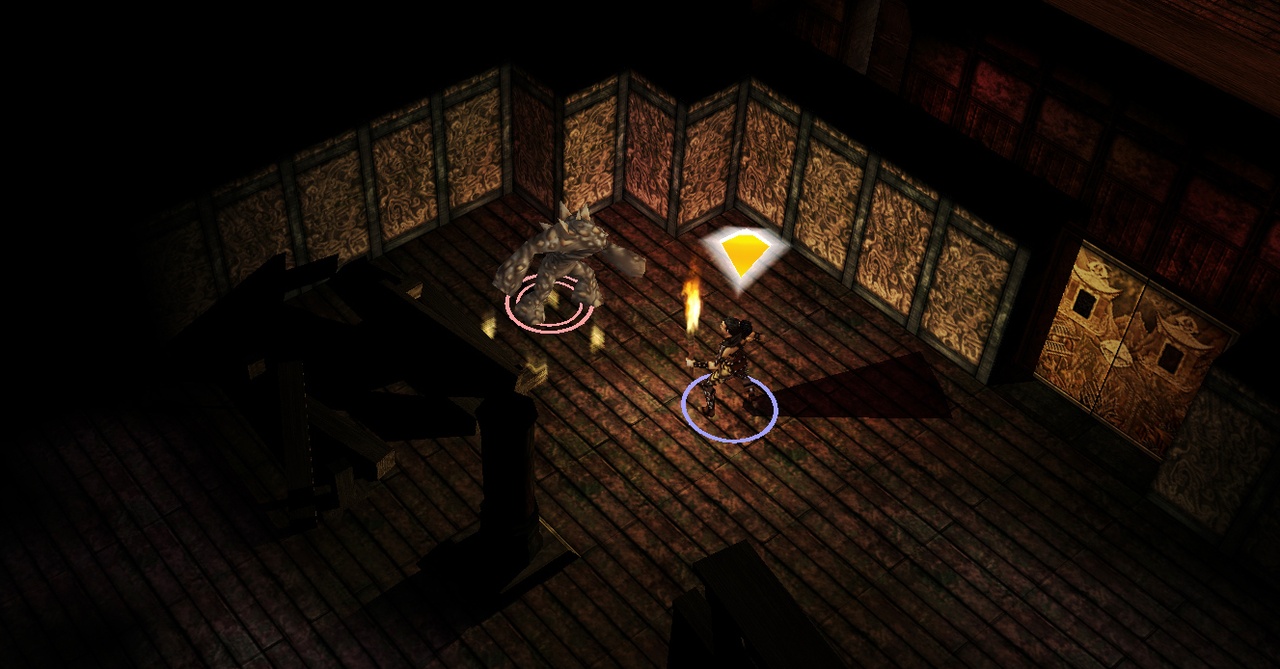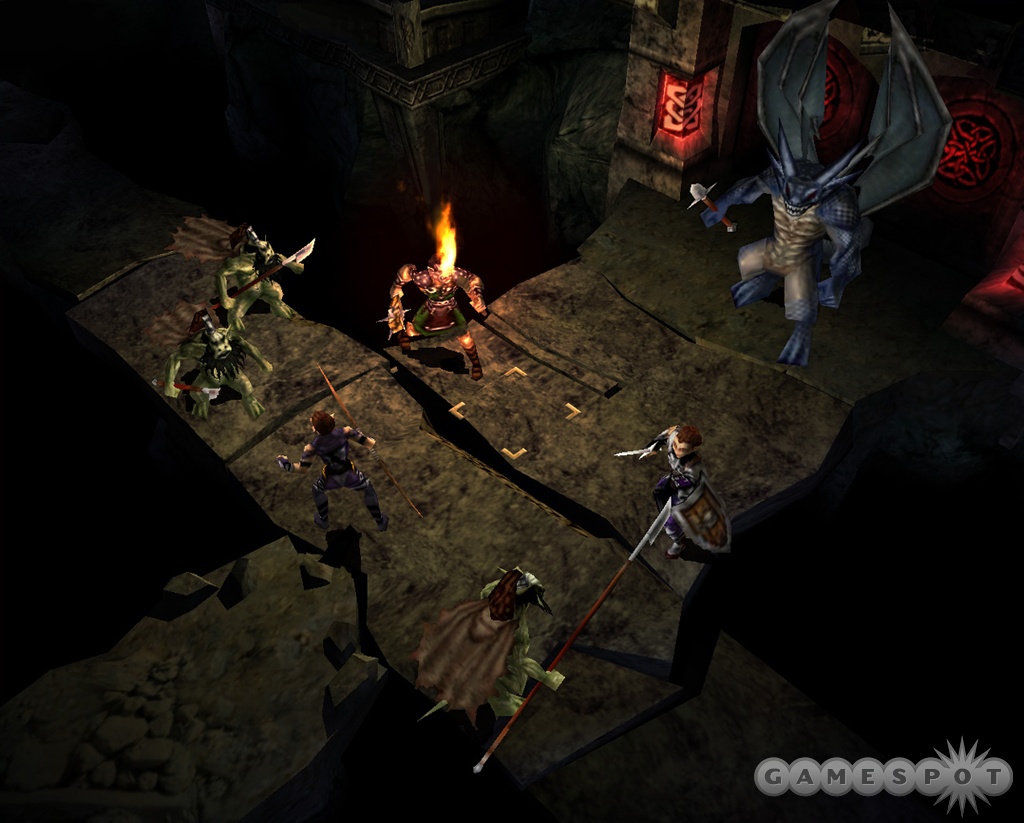Dungeons & Dragons Tactics Updated Hands-On
We spend some quality time with a near-finished version of this turn-based strategy role-playing game.
Currently in development at UK-based Kuju Entertainment, Dungeons & Dragons Tactics is a PSP-exclusive turn-based role-playing game. While adhering to the D&D revised 3rd edition rule set that was published in 2003, D&D Tactics promises to cater to both hardcore fans and newcomers alike. It does so by eliminating the need for dice collections, likeminded friends, and someone who knows the game well enough to assume the rule of DM (dungeon master). We recently received a near-finished version of D&D Tactics and, although we've only played through a handful of the 40-plus missions so far, we couldn't wait to let you know how we've been getting on any longer.

It was more than six months ago that we last spent any time with D&D Tactics, so the first thing we did was check out the tutorials for a refresher course on how the game is played. The four interactive tutorials deal with actions, melee combat, ranged combat, and magic, respectively. It doesn't take long to play through the tutorials. They spend more time familiarizing you with the controls than with the rules of D&D, but when you get into the game, you'll find that explanations for just about any action or item that you can highlight can be viewed at the touch of a button. A glossary with explanations of more than 130 terms commonly used in D&D can also be accessed from the main menu and is well worth a look because it also details many of the rules relating to those terms. For example, you'll likely have no problem figuring out that a "deafened" character can't hear, but the glossary goes on to explain that in gameplay, a deafened character will receive a minus four penalty on initiative checks, automatically fail listen checks, and have a 20 percent chance of failure when casting any spell with a verbal component. This is good to know, but nothing you'll concern yourself with too much because your PlayStation Portable will be doing all of the DM work.
In fact, your PSP will be doing so much behind-the-scenes work that it's quite easy to forget that D&D Tactics is so closely based on the pen-and-paper game at all. You don't see any of the numerous dice rolls that every turn entails; you don't need to do any calculations to determine if an action or an attack is successful; and if you don't want to, you don't even have to go through the somewhat lengthy character creation process before starting your adventure. You'll need to choose a party of six characters, including yourself, before starting the game proper, which can include any combination of premade and custom characters. Every character you create can be male or female (the differences are purely cosmetic) and one of seven races: human, dwarf, elf, gnome, half-elf, halfling, or half-orc. Your choice of race will determine not only your physical appearance but also certain abilities. You movement speed, ability to see in the dark, and resistance to certain magic types are among the more obvious abilities. And, in some cases, you'll find that your chosen race is better suited to certain classes. There are no fewer than 13 classes to choose from in D&D Tactics, including barbarian, bard, cleric, druid, fighter, monk, paladin, psion, psychic warrior, ranger, rogue, sorcerer, and wizard. Further customization options include: allocating points to strength, dexterity, constitution, intelligence, wisdom, and charisma; choosing one of nine alignments; choosing one of 18 deities; after which, the end of the character creation process will be in sight. Before embarking on his or her first mission, your character will still need some of the 25 available skills (such as autohypnosis, bluff, escape artist, or intimidate); a couple of the game's 38 feats (such as acrobatic, blind fight, combat reflexes, or stealthy); and a portrait that will be used in the conversational 2D cutscenes that tell your character's story between missions. Last but not least, you'll get to choose the appearance of the 3D model that will represent your character during play and give him or her a name.
Based on what we've played so far, Dungeons & Dragons Tactics looks like it'll do a good job of easing you into the game proper by starting you out with missions in which you only control two or four characters. It's also worth noting that low-level D&D characters have relatively few skills and abilities in their arsenals, so the long list of actions that you can ultimately perform will generally be introduced to you one or two at a time as you level up. Each turn that you take with one of your characters comprises two phases: movement and action. When it's a character's turn, you'll notice that every square on the grid that he or she can reach is highlighted blue. You'll move simply by selecting the square that you want to move to, though you'll occasionally want to tweak the route your character takes so he or she can avoid getting too close to an enemy. For the most part, the basic "move" command is sufficient for getting around. But as you learn the rules (or if you're already familiar with them), you might wish to experiment with more advanced movement options, such as tumbling and taking individual steps. A similar selection of advanced options is available each time you attack an enemy. The movement phase of your turn can also be used to perform simple actions, such as opening a chest and drawing or reloading a weapon. During the standard action phase, which can be used for additional movement if you have nothing else to do, you'll get to attack enemies, perform magic, consume potions, and so on.

The missions that we've played through thus far have required us to either kill all of the enemies on the map or hunt down a particular enemy. One of the trickiest things has been ensuring that we don't complete our objectives before we've had a chance to open all of the treasure chests we've managed to locate. It's also been a little frustrating to see our characters (and their enemies) swinging their weapons for numerous turns without managing to hit each other, but it's clear that this will become a less common occurrence as their skills improve. At the end of each mission, you'll be shown a results screen that details certain aspects of your performance, such as how many monsters you killed, how much gold you acquired, and how much experience your characters earned from kills. Whether or not the scores you achieve here will play any part in unlocking additional content or gallery artwork is unclear at this time.
In addition to the single-player adventure, D&D Tactics will feature both cooperative and competitive multiplayer modes. Deathmatch mode will let you pit your party against that of a friend, while dungeon bash mode will let you team up with other players to fight your way through a level. We haven't had an opportunity to check out the multiplayer content yet, so we're unsure whether the levels used in dungeon bash mode will be taken from the single-player game, specially designed for the co-op mode, or randomly generated. But Atari and Kuju have confirmed that they're planning to release downloadable content for D&D Tactics after its release, so longevity shouldn't be a problem. We look forward to bringing you more information as soon as it becomes available.
Got a news tip or want to contact us directly? Email news@gamespot.com
Join the conversation